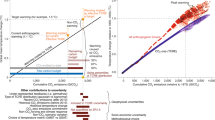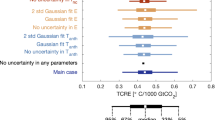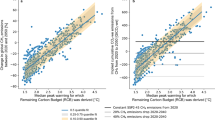Abstract
Concrete actions to curtail greenhouse gas emissions have so far been limited on a global scale1, and therefore the ultimate magnitude of climate change in the absence of further mitigation is an important consideration for climate policy2. Estimates of fossil fuel reserves and resources are highly uncertain, and the amount used under a business-as-usual scenario would depend on prevailing economic and technological conditions. In the absence of global mitigation actions, five trillion tonnes of carbon (5 EgC), corresponding to the lower end of the range of estimates of the total fossil fuel resource3, is often cited as an estimate of total cumulative emissions4,5,6. An approximately linear relationship between global warming and cumulative CO2 emissions is known to hold up to 2 EgC emissions on decadal to centennial timescales7,8,9,10,11; however, in some simple climate models the predicted warming at higher cumulative emissions is less than that predicted by such a linear relationship8. Here, using simulations12 from four comprehensive Earth system models13, we demonstrate that CO2-attributable warming continues to increase approximately linearly up to 5 EgC emissions. These models simulate, in response to 5 EgC of CO2 emissions, global mean warming of 6.4–9.5 °C, mean Arctic warming of 14.7–19.5 °C, and mean regional precipitation increases by more than a factor of four. These results indicate that the unregulated exploitation of the fossil fuel resource could ultimately result in considerably more profound climate changes than previously suggested.
This is a preview of subscription content, access via your institution
Access options
Subscribe to this journal
Receive 12 print issues and online access
$209.00 per year
only $17.42 per issue
Buy this article
- Purchase on Springer Link
- Instant access to full article PDF
Prices may be subject to local taxes which are calculated during checkout




Similar content being viewed by others
References
Friedlingstein, P. et al. Persistent growth of CO2 emissions and implications for reaching climate targets. Nature Geosci. 7, 709–715 (2014).
Swart, N. C. & Weaver, A. J. The Alberta oil sands and climate. Nature Clim. Change 2, 134–136 (2012).
Resources to Reserves 2013: Oil, Gas and Coal Technologies for the Energy Markets of the Future (International Energy Agency, 2013).
Moomaw, W. et al. in Climate Change 2001: Mitigation (eds Pichs-Madruga, R. & Ishitani, H.) Ch. 3 (IPCC, Cambridge Univ. Press, 2001).
Cowie, J. Climate Change: Biological and Human Aspects (Cambridge Univ. Press, 2013).
Henderson-Sellers, A. & McGuffie, K. The Future of the World’s Climate (Elsevier Science, 2011).
Collins, M. et al. in Climate Change 2013: The Physical Science Basis (eds Stocker, T. F. et al.) 1029–1136 (IPCC, Cambridge Univ. Press, 2013).
Allen, M. R. et al. Warming caused by cumulative carbon emissions towards the trillionth tonne. Nature 458, 1163–1166 (2009).
MacDougall, A. H. & Friedlingstein, P. The origin and limits of the near proportionality between climate warming and cumulative CO2 emissions. J. Clim. 28, 4217–4230 (2015).
Gillett, N. P., Arora, V. K., Matthews, D. & Allen, M. R. Constraining the ratio of global warming to cumulative CO2 emissions using CMIP5 simulations. J. Clim. 26, 6844–6858 (2013).
Matthews, H. D., Gillett, N. P., Stott, P. A. & Zickfeld, K. The proportionality of global warming to cumulative carbon emissions. Nature 459, 829–832 (2009).
Meinshausen, M. et al. The RCP greenhouse gas concentrations and their extensions from 1765 to 2300. Climatic Change 109, 213–241 (2011).
Taylor, K. E., Stouffer, R. J. & Meehl, G. An overview of CMIP5 and the experiment design. Bull. Am. Meteorol. Soc. 93, 485–498 (2012).
Zickfeld, K. et al. Long-term climate change commitment and reversibility: an EMIC intercomparison. J. Clim. 26, 5782–5809 (2013).
Arora, V. K. et al. Carbon-concentration and carbon-climate feedbacks in CMIP5 Earth system models. J. Clim. 26, 5289–5314 (2013).
Friedlingstein, P. et al. Uncertainties in CMIP5 climate projections due to carbon cycle feedbacks. J. Clim. 27, 511–526 (2014).
Randerson, J. T. et al. Multi-century changes in ocean and land contributions to the climate-carbon feedback. Glob. Biogeochem. Cycles 29, 744–759 (2015).
Eby, M. et al. Historical and idealized climate model experiments: an intercomparison of Earth system models of intermediate complexity. Clim. Past 9, 1111–1140 (2013).
Arora, V. K. & Boer, G. J. Terrestrial ecosystems response to future changes in climate and atmospheric CO2 concentration. Biogeosciences 11, 4157–4171 (2014).
MacDougall, A. H., Avis, C. A. & Weaver, A. J. Significant contribution to climate warming from the permafrost carbon feedback. Nature Geosci. 5, 719–721 (2012).
Arora, V. K. et al. The effect of terrestrial photosynthesis down regulation on the twentieth-century carbon budget simulated with the CCCma Earth System Model. J. Clim. 22, 6066–6088 (2009).
Frölicher, T. L. & Paynter, D. J. Extending the relationship between global warming and cumulative carbon emissions to multi-millennial timescales. Environ. Res. Lett. 10, 075002 (2015).
Gillett, N. P., Arora, V. K., Zickfeld, K., Marshall, S. J. & Merryfield, W. J. Ongoing climate change following a complete cessation of carbon dioxide emissions. Nature Geosci. 4, 83–87 (2011).
IPCC Climate Change 2014: Impacts, Adaptation, and Vulnerability (eds Field, C. B. et al.) (Cambridge Univ. Press, 2014).
Gregory, J. M., Andrews, T. & Good, P. The inconstancy of transient climate sensitivity under increasing CO2 . Phil. Trans. R. Soc. A 373, 20140417 (2015).
Herrington, T. & Zickfeld, K. Path dependence of climate and carbon cycle response over a broad range of cumulative carbon emissions. Earth Syst. Dyn. 5, 409–422 (2014).
Chadwick, R., Boutle, I. & Martin, G. Spatial patterns of precipitation change in CMIP5: why the rich do not get richer in the tropics. J. Clim. 26, 3803–3822 (2013).
IPCC Summary for Policymakers in Climate Change 2013: The Physical Science Basis (eds Stocker, T. F. et al.) (Cambridge Univ. Press, 2013).
Frame, D. J., Macey, A. H. & Allen, M. R. Cumulative emissions and climate policy. Nature Geosci. 7, 692–693 (2014).
Sherwood, S. C. & Huber, M. An adaptability limit to climate change due to heat stress. Proc. Natl Acad. Sci. USA 107, 9552–9555 (2010).
Acknowledgements
We thank M. Berkley for assistance in accessing data, and G. Boer and N. Swart for providing comments on the initial version of the manuscript. We acknowledge the World Climate Research Programme’s Working Group on Coupled Modelling, which is responsible for CMIP, and we thank the climate modelling groups for producing and making available their model output. For CMIP the US Department of Energy’s Program for Climate Model Diagnosis and Intercomparison provides coordinating support and led development of software infrastructure in partnership with the Global Organization for Earth System Science Portals. We acknowledge EMIC AR5 contributors for providing data for EMIC inter-comparison.
Author information
Authors and Affiliations
Contributions
N.P.G. and A.J.W. designed the study. K.B.T. collected and analysed data. K.B.T. and N.P.G. interpreted the data and wrote the manuscript. V.K.A. assisted in calculating cumulative carbon emissions and provided manuscript feedback. M.E. assisted in EMIC data analysis and understanding of processes represented by EMICs.
Corresponding author
Ethics declarations
Competing interests
The authors declare no competing financial interests.
Supplementary information
Supplementary Information
Supplementary Information (PDF 3695 kb)
Rights and permissions
About this article
Cite this article
Tokarska, K., Gillett, N., Weaver, A. et al. The climate response to five trillion tonnes of carbon. Nature Clim Change 6, 851–855 (2016). https://doi.org/10.1038/nclimate3036
Received:
Accepted:
Published:
Issue Date:
DOI: https://doi.org/10.1038/nclimate3036
This article is cited by
-
The Role of Remaining Carbon Budgets and Net-Zero CO2 Targets in Climate Mitigation Policy
Current Climate Change Reports (2022)
-
Asymmetry in the climate–carbon cycle response to positive and negative CO2 emissions
Nature Climate Change (2021)
-
An integrated approach to quantifying uncertainties in the remaining carbon budget
Communications Earth & Environment (2021)
-
Impact of 1, 2 and 4 °C of global warming on ship navigation in the Canadian Arctic
Nature Climate Change (2021)
-
Optimal Emission Prices Over the Business Cycles
Environmental and Resource Economics (2021)



